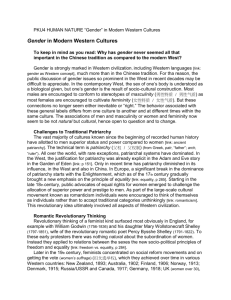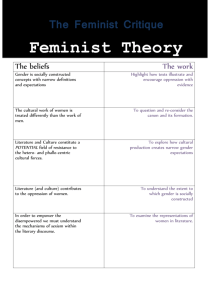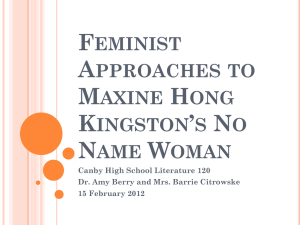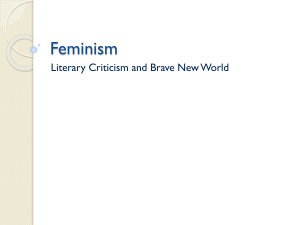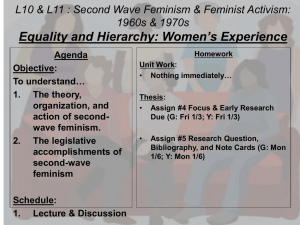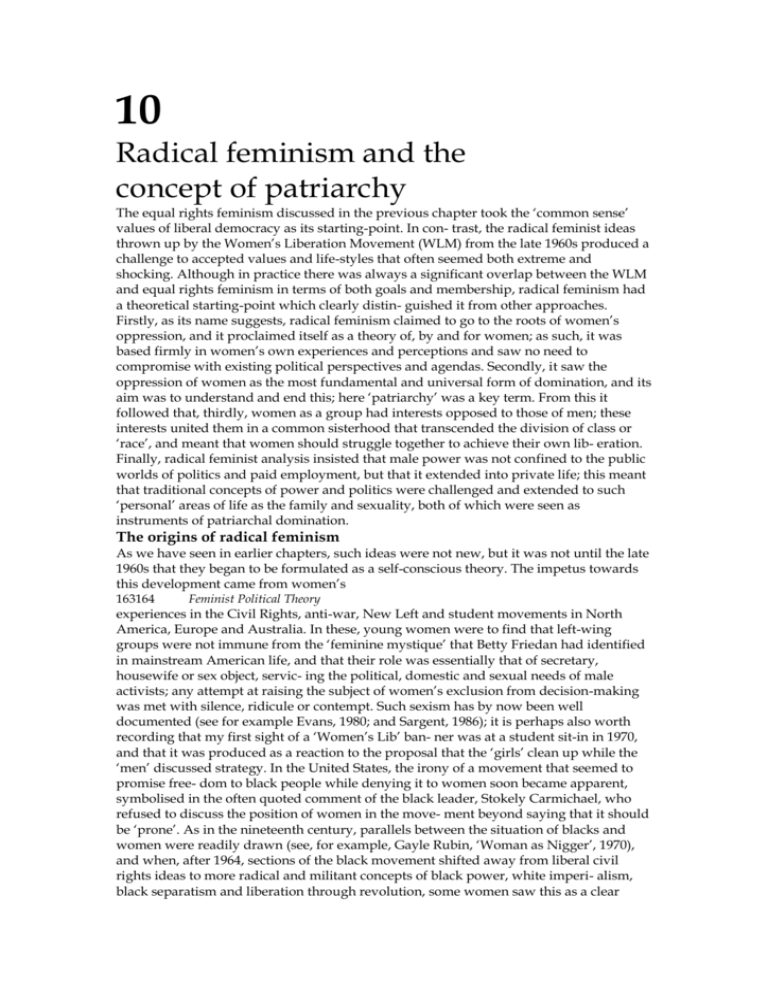
10
Radical feminism and the
concept of patriarchy
The equal rights feminism discussed in the previous chapter took the ‘common sense’
values of liberal democracy as its starting-point. In con- trast, the radical feminist ideas
thrown up by the Women’s Liberation Movement (WLM) from the late 1960s produced a
challenge to accepted values and life-styles that often seemed both extreme and
shocking. Although in practice there was always a significant overlap between the WLM
and equal rights feminism in terms of both goals and membership, radical feminism had
a theoretical starting-point which clearly distin- guished it from other approaches.
Firstly, as its name suggests, radical feminism claimed to go to the roots of women’s
oppression, and it proclaimed itself as a theory of, by and for women; as such, it was
based firmly in women’s own experiences and perceptions and saw no need to
compromise with existing political perspectives and agendas. Secondly, it saw the
oppression of women as the most fundamental and universal form of domination, and its
aim was to understand and end this; here ‘patriarchy’ was a key term. From this it
followed that, thirdly, women as a group had interests opposed to those of men; these
interests united them in a common sisterhood that transcended the division of class or
‘race’, and meant that women should struggle together to achieve their own lib- eration.
Finally, radical feminist analysis insisted that male power was not confined to the public
worlds of politics and paid employment, but that it extended into private life; this meant
that traditional concepts of power and politics were challenged and extended to such
‘personal’ areas of life as the family and sexuality, both of which were seen as
instruments of patriarchal domination.
The origins of radical feminism
As we have seen in earlier chapters, such ideas were not new, but it was not until the late
1960s that they began to be formulated as a self-conscious theory. The impetus towards
this development came from women’s
163164
Feminist Political Theory
experiences in the Civil Rights, anti-war, New Left and student movements in North
America, Europe and Australia. In these, young women were to find that left-wing
groups were not immune from the ‘feminine mystique’ that Betty Friedan had identified
in mainstream American life, and that their role was essentially that of secretary,
housewife or sex object, servic- ing the political, domestic and sexual needs of male
activists; any attempt at raising the subject of women’s exclusion from decision-making
was met with silence, ridicule or contempt. Such sexism has by now been well
documented (see for example Evans, 1980; and Sargent, 1986); it is perhaps also worth
recording that my first sight of a ‘Women’s Lib’ ban- ner was at a student sit-in in 1970,
and that it was produced as a reaction to the proposal that the ‘girls’ clean up while the
‘men’ discussed strategy. In the United States, the irony of a movement that seemed to
promise free- dom to black people while denying it to women soon became apparent,
symbolised in the often quoted comment of the black leader, Stokely Carmichael, who
refused to discuss the position of women in the move- ment beyond saying that it should
be ‘prone’. As in the nineteenth century, parallels between the situation of blacks and
women were readily drawn (see, for example, Gayle Rubin, ‘Woman as Nigger’, 1970),
and when, after 1964, sections of the black movement shifted away from liberal civil
rights ideas to more radical and militant concepts of black power, white imperi- alism,
black separatism and liberation through revolution, some women saw this as a clear
model for a female liberation that went far beyond liberal ideas of equal rights. From this
new perspective, women were involved in a revolutionary struggle against men that
could not be won by polite requests for equal opportunities or changes in the law; far
from seeking respectability and acceptance within the system, feminists were now
committed to its overthrow.
Despite these origins in black movements, many critics claim that from its inception
radical feminism has been rooted in racist assumptions. There had always been social,
racial and sexual tensions between black and white women in the civil rights movement
and, although black women had been to the forefront of early complaints about sexism,
they rapidly became invisible in a movement that contrasted the demands of blacks and
women, as if black women did not exist (see Evans, 1980, and Spelman, 1988). Insistence on
the oppression shared by all women also obscured the very real differences that existed
amongst women, and seemed to deny the possibility that women could oppress each
other.
The systematic articulation of a black feminist critique lay however in the future, and in
the first heady years of the new movement such problems seemed easily ignored. In
1967, the first radical women’s groups were formed in the United States. Influenced by
Maoist ideas current in left-wing circles, these used the Chinese communist idea of
‘speaking
Radical Feminism and the Concept of Patriarchy 165
bitterness’ to express and share personal experiences so as to bring out their political
implications and to develop a political strategy for change. This approach, which also
drew on ‘Old Left’ ideas about enabling work- ers to recognise their collective oppression
and potential power (Weigland, 2001:151), became known as ‘consciousness raising’ and
was of central importance in this period as women broke years of silence to dis- cover the
shared nature of problems which they had assumed to be theirs alone. Later, some
women tended to use consciousness-raising as a form of therapy which articulated
problems to which individualistic solutions could be found; originally, however, it was a
self-consciously political strategy, based on the premise that women’s problems were
shared and that they could only be ended by collective political action (see Morgan, 1970
and Brooke, 1978). As new groups spread rapidly, the key message was that ‘the
personal is political’, and that a new theory and strategy for women’s liberation could
only be based on women’s shared experiences, not on abstract speculation. From this
perspective, no aspect of life lacked a political dimension and political struggle could
therefore take many new forms; women’s struggle could not be postponed until ‘after the
revolu- tion’ but was a matter for immediate political action, and was to be waged
against the universal oppressor–man. Such views were epitomised by the New York
Redstockings manifesto of 1969:
Women are an oppressed class. Our oppression is total, affecting every facet of our lives. We are
exploited as sex objects, breeders, domestic servants, and cheap labor. We are considered inferior beings
whose only purpose is to enhance men’s lives ... we have been kept from seeing our personal suffering
as a political condi- tion ... the conflicts between individual men and women are political conflicts that
can only be solved collectively ... We identify the agents of our oppression as men. Male supremacy is
the oldest, most basic form of domination...All men receive economic, sexual, and psychological benefits
from male supremacy. All men have oppressed women. (in Morgan, 1970:598)
Kate Millett and the theory of patriarchy
By the early 1970s, these new ideas were reflected in a substantial body of literature that
included Kate Millett’s Sexual Politics, Shulamith Firestone’s The Dialectic of Sex,
Germaine Greer’s The Female Eunuch and Eva Figes’ Patriarchal Attitudes (all first
published in 1970); anthologies of some of the new manifestos, speeches and articles
were also published in Betty and Theodore Roszak’s Masculine/ Feminine (1969), Robin
Morgan’s Sisterhood is Powerful (1970), Leslie Tanner’s Voices from Women’s Liberation
(1970) and Michelle Wandor’s The Body Politic (1972). While all of these were important
166
Feminist Political Theory
manifestations of the new movement, it is the second chapter of Millett’s Sexual Politics
that was of the most theoretical importance, as it introduced into feminist thought the
key concept of patriarchy.
The term patriarchy was not of course new to political theory, but the use to which
Millett put it certainly was. Derived from the Greek patriarches, meaning ‘head of the
tribe’, it was central to seventeenth-century debates over the extent of monarchical
power; here supporters of absolute rule claimed that the power of a king over his people
was the same as that of a father over his family, and that both were sanctioned by God
and nature. Millett seemed to take such familial power as her starting-point, so that ‘the
principles of patriarchy appear to be twofold: male shall dominate female, elder male
shall dominate young’ (Politics:25). It was, however, only the first of these principles that
she explored, and she did not distin- guish between male power within the family and in
society as whole; despite the efforts of some writers to restrict the term to strictly familybased power (see Randall, 1987:20; and Cocks, 1989), its use as a short- hand for a social
system based on male domination and female subordination has become standard
amongst feminists.
Millett’s central claims were simple, and they essentially represented a formalisation of
the ideas that were already current in the new women’s movement. She argued that in all
known societies relationships between the sexes have been based on power, and that
they are therefore political. This power takes the form of male domination over women
in all areas of life; sexual domination is so universal, so ubiquitous and so complete that
it appears ‘natural’ and hence becomes invisible, so that it is ‘perhaps the most pervasive
ideology of our culture and provides its most fundamen- tal concept of power’
(Politics:25). According to Millett, the patriarchal power of men over women is basic to
the functioning of all societies and it extends far beyond formal institutions of power. It
overrides class and ‘race’ divisions, for economic dependency means that women’s class
iden- tity is a ‘tangential, vicarious and temporary matter’, while ‘sexism may be more
endemic in our society than racism’ (Politics:38 and 39). Patriarchy is primarily
maintained by a process of conditioning which starts with childhood socialisation within
the family and is reinforced by education, literature and religion to such an extent that its
values are internalised by men and women alike; for some women this leads to selfhatred, self- rejection and an acceptance of inferiority. Millett further argued that, despite
the success of this ‘interior colonisation’, patriarchy also rests upon economic
exploitation and the use or threat of force. This means that its history is a record of man’s
inhumanity to woman and that the thousands of women who die in the United States
each year as a result of illegal abortion are victims of the same system as the Indian
woman forced to die on her husband’s funeral pyre, the Chinese woman crippled by
Radical Feminism and the Concept of Patriarchy 167
foot-binding and the African girl whose clitoris is cut out. In all societies too, patriarchy
relies upon sexual violence and rape. In this context, sexual relations between men and
women are but an expression of male power, and Millett devoted a large section of her
book to ‘deconstructing’ the portrayal of sex in the work of four major twentieth-century
writers (D. H. Lawrence, Henry Miller, Norman Mailer and Jean Genet) so as to reveal
the crude sexual domination involved. Love, too, can be but a con- fidence trick, part of a
patriarchal ideology designed to hide the realities of power; not until patriarchy has been
overthrown and sexuality radi- cally transformed can men and women relate as equal
human beings.
Criticisms of the concept of patriarchy
For many women, Millett’s ideas were a revelation, enabling separate pieces of
knowledge and experience to ‘click’ into place, and transforming the way they saw the
world (Tobias, 1997:5 and 192). As discussed in the following sections, the radical
feminist concept of patriarchy has, how- ever, been heavily criticised by other feminists,
and has been accused of being both politically counter-productive and based on sloppy,
over- ambitious and dangerously misleading theoretical assumptions (for influ- ential
early criticisms, see Rowbotham, 1982 and Beechey, 1979). My own view is that
‘patriarchy’ can be an illuminating concept, but not a fully- fledged theory, and that if
used carefully it can avoid the problems that critics have identified (see Bryson, 1999b).
Politics and personal life
The claim that ‘the personal is political’ is central to the concept of patriarchy. Some
critics say that this has totalitarian implications, for it implies that no area of life can be
free from political scrutiny and that femi- nists are to be held accountable to their ‘sisters’
for their every aspect of their behaviour; according to Natasha Walter, such a ‘politically
correct’ approach believes that feminism is incompatible with enjoyment of fashion or
hetero- sexuality (Walter, 1998). Other critics argue that the insistence that the per- sonal
is political is effectively de-politicising, as it can seem to suggest that feminists can never
hope to change the world before they have put their own personal houses in impeccable
order; as such, it legitimises a privatised and self-indulgent retreat from collective
struggle and into the seductive world of open-ended therapy, counselling and
‘alternative’ healing.
Although some women may have interpreted it in these ways, these criticisms are not
true of Millett’s original theory, and owe more to media
168
Feminist Political Theory
hype than radical feminist analysis. In 1996, a new international collection of essays by
sixty-eight self-proclaimed radical feminists, Radically Speaking, defended their position
against such misinterpretation, and made it clear that they were not demanding that
private life should become polit- ical, but claiming that it already is. From this perspective,
current notions of privacy conceal many of the ways in which women are oppressed, but
the question of whether we should have a right to private life can be left open. Several
contributors also explicitly stated that their goal was not individual therapy but
collective action (Bell and Klein (eds), 1996).
A merely descriptive approach?
In describing her work as ‘notes towards a theory of patriarchy’ (Politics:24), Millett
seemed to imply that she was doing much more than simply describing male power;
critics, however, say that both she and later feminist writers on patriarchy have confused
description with explanation and that, despite their theoretical pretensions, they have
provided only the former; they have, in short, both claimed too much and delivered too
little (see for example Beechey, 1979; Gardiner, 1997; Whelehan, 1995).
Even at its most basic level, however, the concept of patriarchy was not confined to
description; nor could it be. Deciding which ‘facts’ are politi- cally significant inevitably
involves theoretical assumptions; in describing facts that had previously gone
unremarked, feminist discussions of patri- archy made these assumptions explicit, and
thereby provided a profound challenge to conventional political theory and the
definition of politics itself. This may not constitute a fully-fledged theory; but it does
provide the basis for analysis and understanding which goes well beyond simple
description.
Millett did not claim to provide a theory of the origins of patriarchy, although she was
clear that patriarchy must be understood in its own terms rather than as a product of
class society. Other writers have, how- ever, been less reticent, and by the late 1980s there
seemed to be a fairly widespread consensus that a matriarchy in which women were in
posi- tions of power and domination has never existed, but that some very early societies
have been much more woman-centred than our own, and that some may have been
based on matrilineal descent and a degree of sexual equality (see Lerner, 1986). For some
radical feminists, the original shift to patriarchy was simply a consequence of men’s
greater strength, stemming from women’s weakness during pregnancy, childbirth and
lactation; for others, it was above all men’s ability to rape that enabled them to dominate women (Brownmiller, 1977). Some, however, claimed that it was the discovery of
the male role in reproduction that was critical and first led
Radical Feminism and the Concept of Patriarchy 169
men to seek to control women. Thus Rich wrote that:
A crucial moment in human consciousness arrives when man discovers that it is he himself, not the
moon or the spring rains or the spirits of the dead, who impreg- nates the woman; that the child she
carries and gives birth to is his child, who can make him immortal. (Rich, 1977:60; see also Figes, 1970;
O’Brien, 1981)
Yet others saw the development of patriarchy as rooted in the early devel- opment of
hunting by men, which both gave them a new source of power and led to the
development of a value system based on violent conquest (see French, 1985; Collard,
1988; Mies, 1998).
There has therefore been no radical feminist agreement as to the causes or origins of
patriarchy, and some see this as a flaw, arguing that if we do not understand the origins
of women’s oppression we cannot develop a strategy for ending it. Spender, however,
did not think this was the case. Like Millett, who refused to become involved in ‘the
evanescent delights afforded by the game of origins’, on the grounds that ‘Conjecture
about origins is always frustrated by lack of evidence. Speculation about prehistory...remains nothing but speculation’ (Politics:28 and 29), she argued that:
We do not need definite evidence of the first cause to know that men have power, that they have had it
for a very long time, that they seem to have had it in every known human society, and that they now
use it to keep their power. (Spender, 1985b:42)
From this perspective, what is important is to identify and understand the structures and
institutions that maintain patriarchy today in order that these may be overthrown, and
this Millett and later writers have attempted to do.
The theoretical stakes are however raised if it is claimed that patriarchy should be
defined as a system of male domination and female subordina- tion or oppression (see for
example, Walby, 1990:20; Cockburn, 1991:6; Rowland and Klein, 1996:15; Tobias, 1997:ix).
Here, there is a clear danger of slipping into more ambitious explanatory claims which
are based on tautology (men dominate women because they have more power) rather
than on the identification of genuine causal relationships. As Anna Pollert has argued, it
is not appropriate to treat patriarchy as a system in the same sense as the capitalist
market economy, for patriarchy does not have an internal dynamic that is equivalent to
the capitalist pursuit of profit: even the most well-intentioned capitalist must exploit his
workers or go out of business, but men’s relationship with women does not have to be
exploitative, however deep-seated women’s oppression might be
170
Feminist Political Theory
(Pollert, 1996; see also Acker, 1989). Nevertheless, as I have argued elsewhere (Bryson,
1999b), the concept of ‘system’ can usefully highlight the recurrent and patterned nature
of male power, helping to reveal how its dif- ferent manifestations reinforce each other,
so that patriarchy is more than the sum of its parts. This stress on interconnection also
suggests that feminist challenges to male power in one area can have knock-on effects in
others.
An over-generalised and a-historical account?
For many writers, the task of understanding patriarchy involved the identification of
women’s oppression across cultures and nations and over time. Thus, for example,
Adrienne Rich’s account of patriarchy explicitly abstracted the position of women from
any social context:
Under patriarchy, I may live in purdah or drive a truck; I may raise my children in a kibbutz, or be the
sole breadwinner for a fatherless family ... I may serve my hus- band his early-morning coffee within
the clay walls of a Barbar village or march in an academic procession; whatever my status or situation,
my derived economic class or my sexual preference, I live under the power of the fathers, and have
access only to so much of privilege or influence as the patriarchy is willing to accede to me, and only for
so long as I will pay the price for male approval. (Rich, 1977:58)
Similarly, Andrea Dworkin linked the pre-revolutionary Chinese practice of foot-binding
to the girdles, high heels and eyebrow plucking dictated by American fashion, claiming
that for all women ‘Pain is an essential part of the grooming process and that is not
accidental ... [it] serves to prepare women for lives of childbearing, self-abnegation and
husband-pleasing’ (Dworkin, 1974:115). Mary Daly too claimed that such horrors as footbinding, witch-burning, genital mutilation and modern American gynaecology are all
essentially similar manifestations of the universal system of male tyranny, so that the
situation of women is basically the same whether they live in Saudi Arabia or Sweden,
and ‘Even outer space and the future have been colonized’ (Daly, 1973, and 1978:1).
At one level, such analyses have an intuitive appeal and contain a kind of truth. It is not
necessary to believe in the immutable and biologically based ‘badness’ of men to agree
that women in radically different societies or situations frequently have experiences in
common involving sexual exploitation, lack of reproductive freedom and
marginalisation or exclu- sion from ‘malestream’ economic, social, political and
intellectual life; these experiences may reflect the systematic (that is, non-random)
exercise of power by men over women. Nevertheless, the idea that all women are
Radical Feminism and the Concept of Patriarchy 171
united in a common sisterhood that transcends all man-made divisions can be
dangerously misleading.
In the first place, a too-easy comparison of women’s experiences across the centuries and
within and between modern societies may trivialise the depth of suffering experienced
by some women. Thus, the oppression experienced by a modern American ‘fashion
victim’ (even one who diets herself to death) is qualitatively different from the suffering
of the generations of Chinese women who were from childhood deliberately and
systematically crippled in the name of erotic attraction, able only to totter painfully
on the outside of toes which had been bent under into the sole of the foot. The heel and instep of the
foot resembled the sole and heel of a high-heeled boot. Hard callouses formed, toe-nails grew into the
skin; the feet were pus-filled and bloody; circulation was virtually stopped. (Dworkin, 1974:101)
Similarly, attempts to compare the experiences of women in very different contemporary
societies that are based on the premise that these are essen- tially ‘the same’, conceal the
vast gap in experience that is involved. For example, lack of reproductive rights has
meant something very different to the Romanian woman forced to bear at least six
children, the Chinese woman forced by the ‘one child’ policy to abort her second, the
white American career woman whose contraception has failed and the Puerto Rican
woman sterilised against her will.
The attempt to universalise women’s experience may conceal other forms of oppression
based on ‘race’ or class or belittle their importance, as from the perspective of the global
and transhistorical oppression of women, racism, militaristic nationalism and economic
exploitation are portrayed as trivial squabbles amongst men. According to some critics,
therefore, the feminist assumption that the concerns of white, middle-class Western
women can be equated with the experiences of all women every- where is itself a form of
cultural imperialism that seeks to disguise the particularity of its own worldview by the
use of spuriously general concepts. This means that ‘patriarchy’ and ‘sisterhood’ may be
mystifying devices that conceal divisions in society in much the same way as male
perspectives have concealed the oppression of women, so that ‘There are disturbing
parallels between what feminists find disquieting in Western political thought and what
many black women have found troubling in much of Western feminism’ (Spelman,
1988:6; see also Moraga and Anzaldua, 1983, especially the article by Lorde; Davis, 1982
and 1990; Feminist Review, no. 17, 1984; Collins, 1990; Ramazanoglu, 1986).
Such criticisms are extremely serious. However, I would argue that they stem from the
use of the concept by some of its less cautious exponents
172
Feminist Political Theory
rather than being inherent in it. To use the concept of patriarchy is not necessarily to
deny that other forms of oppression are at least as impor- tant; rather, it can indicate that
a key feminist task is to explore the ways in which oppressions interconnect.
Some writers on patriarchy have seemed to produce an a-historical accumulation of
descriptions of men’s inhumanity to women which sees women solely as passive victims
of male injustice, so that ‘Women’s pow- erlessness, victimisation and lack of
resources...constitute women’s timeless history’ (Segal, 1987:xi). Again, however, the idea
that societies are structured by male domination need not in itself preclude the possibility of change or resistance. Millett herself never claimed that patriarchy was an
unchanging system of oppression; rather, she argued that as a result of past struggles
women had made ‘monumental progress’ which provided the basis for future change
(Politics:64); by making patriarchy visible and identifying the battles that have to be
fought she saw her own work as itself a part of that struggle.
Later writers have therefore attempted to produce a more sophisticated concept which
argues that, far from being unchanging, patriarchal domi- nation takes a number of
different forms which are the product of partic- ular historical situations. Thus Ferguson
and Walby have both argued that in western societies there has been a general shift away
from private patriarchy based on individual control within the household to a public
patriarchy based on structures outside the home – although Walby cau- tions that this is
‘a continuum rather than a rigid dichotomy’, and has since analysed the complex gains
and losses experienced by different groups of women in different areas of their lives
(Walby, 1990:180 and 1997; Ferguson, 1989; see also Dahlerup, 1987; Cocks, 1989). Such
analysis does not see patriarchy as an unchanging and monolithic structure of oppression, but allows for the possibility that patriarchal power may be chal- lenged and
feminist victories won. This means that changes in the nature or degree of patriarchy
become visible, as do women’s challenges to it.
Women good, men bad: an essentialist view of sex difference?
Although the point was not developed by Millett as much as by some later theorists, a
central message of her work must be that it is not unjust laws or economic systems that
are responsible for women’s oppression but men, that men as a group have interests
opposed to those of women and that it is therefore against the power of men that the
battle must be fought. For many critics such a position is untenable, and is largely
responsible for feminism’s negative image as a complaining, whining, negative creed,
irrelevant to the lives of go-ahead young women (see in particular,
Radical Feminism and the Concept of Patriarchy 173
Wolf, 1993 and Walter, 1998, discussed in Chapter 9 above). They point out that many
men are not in positions of power over women but may in fact be subordinate to them
and that, despite the general imbalance of power, loving and non-exploitative
relationships between men and women can and do exist in our society. Men, too, they
say, may suffer in a sexist soci- ety: for example, they are forced into the role of
breadwinner and denied an active role in bringing up their own children and, by having
to repress unacceptably ‘feminine’ aspects of their personality, they are alienated from
their own full humanity (for overviews of feminist analyses of men’s situation and the
ways that they may be damaged by patriarchy, see Bryson 1999a, 2000). Many men,
critics say, are willing to help women in their struggle, and their support should not be
rejected. Moreover, men cannot be simply ‘killed off’ in the same way as a class enemy
might con- ceivably be; quite apart from humanitarian considerations, this would be a
biological impossibility.
Such criticisms, however, miss the point that the concept of patriarchy does not
necessarily imply that all individual men oppress all women, that each and every male
person is to be considered an enemy incapable of reform, or that the total elimination of
the male sex would be the desired consequence of an improvement in sperm-bank
technology. Indeed, an important aspect of the concept is that it enables us to distinguish
between the structures of male domination on the one hand and individual men on the
other (Dahlerup, 1987; Walby, 1990). This means that the enemy is male power in all its
manifestations and that, as contributors to Radically Speaking make clear, this power is
socially constructed and therefore contestable, rather than embodied in all biological
males.
It remains true that some radical feminists believe that there are essential and irreducible
biological differences that shape men and women’s nature, and that women are naturally
superior. This view has led some to develop an ‘eco-feminist analysis’ (see Chapter 11,
below), while a small minority have rejected all association with men, whether this be
social, sexual or political. Separatist ideas must, however, be disentangled from the
original theory of patriarchy; although the concept of patriarchy can be developed in this
direction, man-hating and separatism are not inherent in it. Far from seeing all men as an
undifferentiated enemy, who can never be trusted as fathers, friends, colleagues, sexual
partners or political allies, the concept can in principle be used to explore the possi- bility
of male support and political solidarity, and to analyse ways in which some or all men
may themselves be harmed by patriarchy.
For postmodernist critics, the rejection of essentialism goes much further. As we shall see
in Chapter 14, postmodernism does not only stress the differences amongst women and
the consequent dangers of generalising about their situation, it also questions the
underlying
174
Feminist Political Theory
assumption (common to all ‘modernist’ feminists) that it is meaningful to talk about
‘women’ and ‘men’ at all. In other words, it destroys the onto- logical basis of any claims
about ‘women’, for the very terms ‘woman’ and ‘man’ are not stable referents to realworld phenomena, but artificial and fluid categories of meaning which should
themselves be challenged. The editors of Radically Speaking have greeted this kind of
analysis with outrage. They claim that postmodernism is a ploy to deny women’s
collective identity just at a time when they are learning to recognise their shared
experiences and act together politically and they proclaim: ‘Stubbornly, defiantly, we
hold on to that truth. There is such a thing as woman’ (Bell and Klein, 1996:xviii). As we
shall see, postmodernism may not be as completely incompatible with collective feminist
politics as this response suggests. Nevertheless, it is clearly difficult to reconcile a
postmodern philosophical stance with the analysis of patriarchy.
The concept of patriarchy today
For some feminists in the 1970s, the beauty of the concept of patriarchy lay in its
simplicity, as it seemed to cut through distracting details and irrele- vant differences to
lay bare the essential, underlying power structure and organising principle of society.
Today, partly because of the impact of post- modernism, such simplicity seems much less
attractive, and the whole search for an overarching theory feels decidedly old-fashioned.
Nevertheless, the concept continues to have widespread currency. At the most general
level, it provides a handle on the world which connects dif- ferent areas of experience,
helps make sense of the hostility generated by seemingly moderate feminist demands
and enables us to see the extent to which male needs and assumptions are still central to
political, cultural and economic life, the norm against which women are measured. Some
of the ways in which it has been applied to ‘private’ and ‘public’ life are explored in the
following chapters.



